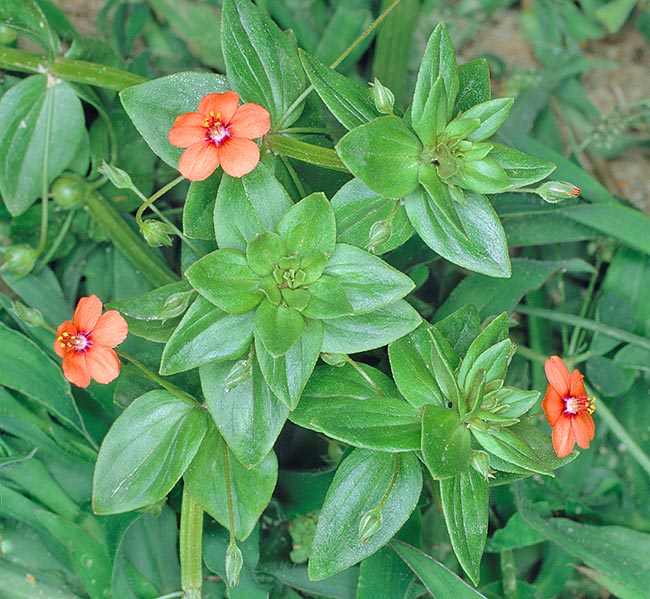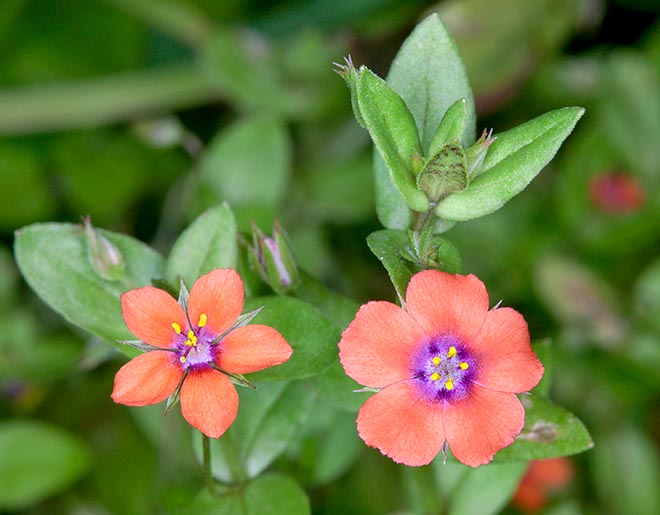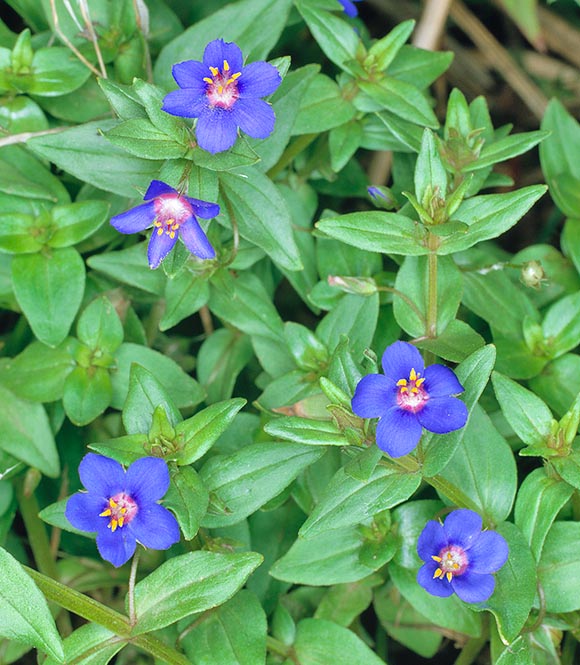Family : Primulaceae

Text © Eugenio Zanotti

English translation by Mario Beltramini

Anagallis arvensis is a small herbaceous now subcosmopolitan, frequent in orchards, cultivated fields, freshly worked soils, road edges and generally in anthropized places up to 1200 m of altitude © Giuseppe Mazza
The genus Anagallis includes, after the various Authors, from 20 to 25 species of herbaceous plants distributed in the temperate and averagely warm zones in various continents of the world, especially Africa, Europe and Madagascar. Following the classical classification it is included in the family of the Primulaceae, whilst after the most recent phylogenetic and morphologic systematics it has been ascribed to the family of the Myrsinaceae. In the system PAG III of 2009, the family of the Primulaceae includes also the Myrsinaceae.
The Scarlet pimpernel (Anagallis arvensis L. 1753), known also as Red chickweed, Poorman’s barometer, etc. is native to the Euro-Mediterranean range, but nowadays the species is sub-cosmopolitan.
Herbaceous plant, glabrous of with tiny bicellular glandular hairs, usually annual, rarely biennial, exceptionally pluriennial, with fusiform root, often twisted; ascending or prostrate stems, creeping and rooting in the lowest nodes, ascending, ramified from the bottom, diffused, square section with four acute edges or narrow wings, 5-20 cm long (rarely >40 cm). Sessile leaves, opposite or rarely three verticillate, with dark green lamina, ovate-lanceolate (7-11 x 12-16 mm) with entire margin of membranous consistency, usually dotted with brown glands.
Isolated flowers at the axil of the upper leaves, with 5-parted calyx, lanceolate lobes, acuminate, membranous at the margins, on 1-3 cm peduncles with rotated corolla, usually pale red, red brick, antique pink or pink-orange formed by 5 laciniae merged at the base, up to 6 mm broad, often covering each other, with 35-70 3-cellular hairs along the border.

Red, pink or orange flowers reaching 6 mm and opening only in full sun. Poisonous seeds © Giuseppe Mazza
The fruit, supported by the floral peduncles bent downwards, is a spherical capsule (pyxis) pf 3-4 (<6) mm, with 2 mm style and accrescent calyx (5 mm), circumscissile, containing from (12) 20 to 35 (45) tiny seeds (1-1,3 mm) a little three-toned, matt of brown or blackish colour, rough, scaly and papillose.
This plant, small but of great beauty, is moderately hygrophilous and acidophilic, lives in the garigues, in the fallows, in the fields, in the kitchen-gardens, orchards and vineyards, on soil occasionally with stagnating water, from the plain up to 1.200 m (rarely 1.700 m) of altitude. It is a plant diffusing easily in anthropized environments, that is from the road edges and from the disturbed ambients close to the fields, recently stirred lands, which, for the synanthropic stress-tolerant species represent the diffusion habitats.
Very similar is Anagallis foemina which distinguishes for the corolla with laciniae entire or more or less serrate, light blue or pale blue, purplish at the centre, violet below, with scarce (<30) glandular hairs at the margin, mostly 4-cellular, leaves with rare or absent glandular hairs, the upper ones lanceolate; flowers on 0,8-1,2 cm peduncles, finely serrate sepals, wrapping completely the buds. This species is more thermophilous and calciphilous and behaves like an archaeophyte.
The toxic properties of the seeds of the anagallis are known since centuries “… and commonly it is thought by the hoi polloi, that the small birds of our countries envenom, with the seeds of these plants, their young when they see them fallen into man’s slavery, and do this carrying the seeds by themselves as food in the cages where they are kept prisoners”.

Anagallis foemina is a very alike species, deemed as subspecies by some © Giuseppe Mazza
Under the name of scarlet pimpernel it was used as battle name by Sir Percy Blakeney, the hero of the popular novel “The Scarlet Pimpernel”, written by the baroness Emma Orczy and set at the time of the French Revolution.
The whole plant but the roots, harvested from June to August during the blooming (from June to August) and rapidly dried up at the air and preferably in the shade, contains two triterpenoid saponic glucosides, the two enzymes primaverase and cyclamine, one proteolytic ferment, flavonoids, traces of cucurbitacin, bitter and tannic substances, etc., which confer it expectorant properties.
The capacity of increasing the secretion of the glands and of the mucosae extends also to the cutaneous ones, to the liver and the kidneys, is therefore also suitable as detergent, caustic (for eliminating the warts), vulnerary and haemolytic (for external use); diaphoretic, diuretic, cholagogue, biliary deobstruent (in internal use).
It must be said at once that this is a species to be excluded from the family use due to its toxicity which, for internal use, may cause diarrhoea, polyuria, and tremor. In Australia were reported cases of poisoning of grazing sheep having eaten important quantities of Anagallis (the 2% of the animal’s weight), with kidney haemorrhages, of the heart and of the rumen, lung congestion and hepatic abnormalities. In homeopathy, the plant is employed for treating the exanthems, the hepatic and biliary diseases.
The fresh juice, which contains a proteolytic ferment, renders it effective, by means of soaked gauze pads, to induce the healing of murky wounds, of the decubitus ulcers and other skin diseases. We omit preparations based on this species to be employed exclusively under strict medical control.
Synonyms: Anagallis latifolia L. (1753); Anagallis caerulea L. (1759); Anagallis arvensis var. caerulea Gouan (1764); Anagallis arvensis var. phoenicea Gouan (1764); Anagallis phoenicea (Gouan) Scop. (1771); Anagallis coerulea Schreb (1771); Anagallis verticillata All. (1785); Anagallis mas Vill. (1787); Anagallis carnea Schrank (1789); Anagallis arvensis var. phoenicea (Scop.) Baumg. (1790); Anagallis pulchella Salisb. (1796); Anagallis repens DC. (1805); Anagallis punctifolia Stokes (1812); Anagallis indica Sweet (1826); Anagallis parviflora Loisel. (1827); Anagallis arabica Duby (1844); Anagallis jacquemontii Duby (1844); Anagallis orientalis Fisch., C.A.Mey. & Avé-Lall. (1846); Anagallis arvensis subsp. caerulea Hartm. (1846); Anagallis carnosa Kit. in Kanitz (1863); Anagallis arvensis subsp. parviflora (Hoffmanns. & Link) Arcang. (1882); Anagallis arvensis subsp. platyphylla (Baudo) Batt. (1890) Anagallis arvensis subsp. latifolia (L.) Arcang. (1894); Anagallis arvensis subsp. phoenicea Vollm. (1904); Anagallis arvensis subsp. foemina (Mill.) Schinz & Thell. (1907) ; Anagallis arvensis proles micrantha (Gren.) Rouy (1908) Anagallis arvensis var. caerulea Arechav. (1909); Anagallis arvensis subsp. foemina (Mill.) Schinz & Thell. Ex Schinz & R. Keller (1909); Lysimachia arvensis var. caerulea (L.) Turland & Bergmeier (1911); Anagallis arvensis var. platyphylloides Pau (1924) ; Anagallis arvensis subsp. micrantha (Gren.) P.Fourn. (1937); Anagallis arvensis f. azurea Hyl (1945); Anagallis hadidii Chrtek & Osb.-Kos. (1986).
→ To appreciate the biodiversity within PRIMULACEAE family please click here.
